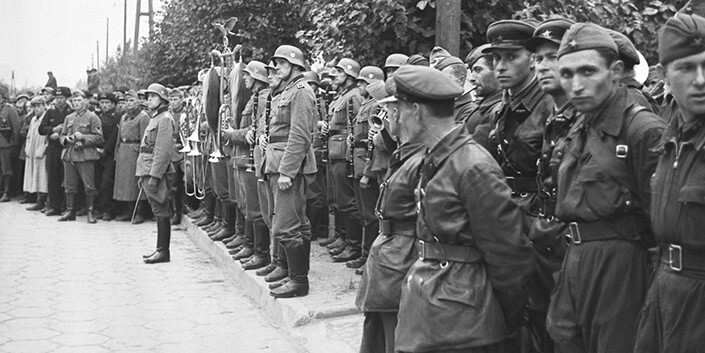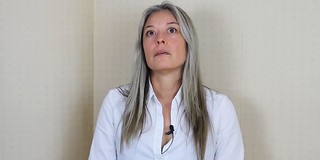The impressive numbers of German communists who joined the Nazi Party
One of the most widespread and questionable ideas about the politics of the 20th century is the one that tends to qualify National-Socialism as a radical right-wing movement.
The desire of the Nazi Party to attract socialists and communists
As the name suggests, Hitler's ideology was a mixture of nationalism and socialism. As I pointed out a few months ago, one of the nazi dictator's most faithful advisers, Otto Wagener, portrayed him as a convinced socialist. In his memoir, "Hitler aus nächster Nähe: Aufzeichnungen eines Vertrauten 1929-1932", written in 1946, Wagener - who never denied the nazi ideology - quoted a few words pronounced by Hitler in a speech before his coming to power, and that reveal his idea about the positioning of Nazism on the political map: "we National Socialists wish precisely to attract all socialists, even the Communists; we wish to win them over from their international camp to the national one."
The Nazis' attempts to recruit socialists and communists came to be ridiculed by the communist weekly magazine Arbeiter-Illustrierte-Zeitung (AIZ). In its number 16, launched on April 19, 1934 from Prague, AIZ published a photomontage in which the Nazi propaganda minister Joseph Goebbels was seen disguising Hitler with a Karl Marx beard, along with this text: "Mimicry. After all attempts to bring National Socialist ideas to the working-class world failed, Göbbels came up with one last desperate idea: he persuaded the 'Führer' to wear a Karl Marx beard every time he spoke to the workers."

The communists' strategy to recruit Nazi militants
The desire to capture the supporters of the other totalitarian ideology was also common to the communists, as I already pointed out here 10 years ago. An example of this occurred in March 1931, when Lieutenant Richard Scheringer, a former member of the Nazi Party (NSDAP), went over to the German Communist Party (KPD), forming in Linden a unit of the Rot Front, the communist militia, called Scheringer Staffel , who wore uniforms of the SA, the Nazi militia, but with communist symbols.
In February 1932, the communist magazine AIZ dedicated an article to Scheringer, entitled: "Why I was a National Socialist and how I became a communist." The case of that lieutenant gave rise to a strategy of the KPD, the Scheringer-Kurs, to attract nazi militants with a speech that mixed socialism with nationalist elements, a strategy that was embodied in a communist pamphlet entitled "Programmerklärung zur nationalen und sozialen Befreiung des deutschen Volkes" (programmatic declaration for the national and social liberation of the German people), a pamphlet published on August 24, 1930, 90 years ago today.

The mass passage of communist militants to the nazi SA
The KPD strategy was much less successful than the recruitment of communist militants by the NSDAP, especially from January 1933, when Hitler took over the Chancellery. In relation to the passage of militants from the KPD to the NSDAP, historian Timothy Scott Brown collected very interesting data in his book "Weimar Radicals: Nazis and Communists between Authenticity and Performance" (Berghahn, 2009), noting on page 136 that in what as regards the SA, "it is known that a significant part of the new recruits previously belonged to the KPD."
Scott exposes the estimates collected by Rudolf Diels, first head of the Gestapo -the political police of the Third Reich-, in his memoirs, "Lucifer Ante Portas: Von Severing bis Heydrich" (1950), pointing out that in Berlin 70% of the new recruits to the SA from January 1933 were former Communists. The most striking fact of those indicated by Diels is that in some cases, entire Rot Front units moved to the SA. However, this flight of militants began before Hitler came to power. According to Sven Reichardt ("Faschistische Kampfbünde. Gewalt und Gemeinschaft im italienischen Squadrismus und in der deutschen SA", Cologne, 2002), the social democrat Albert Grzesinski, head of the Berlin Police between 1930 and 1932, pointed out that 30% of the members of the SA in Berlin were ex-communists as early as 1932.

In his book, Timothy Scott Brown also quotes the estimates of a subordinate of Diels in the Gestapo, whom he quotes as Gisevius (it is understood that he speaks of Hans Bernd Gisevius, an undercover member of the opposition to the regime who was part of that secret police), noting that at least a third of the members of the SA as of 1933 were former communists. These militants were known by their companions as nazi rindersteak (Nazi beef steaks), considering them brown on the outside - in reference to the color of the SA uniform shirt - and red on the inside.
According to the historian, the SA themselves calculated at 55% the number of their militants who came from the communist ranks. Brown also points out that both the Gestapo files and the reports from the KPD intelligence apparatus confirm the considerable presence of former communists in the SA. In some cases, former communist militants held relevant positions in the repressive apparatus of the nazi regime: Scott cites the case of an SS intelligence unit in the Altona district of Hamburg: between 30 and 35 of its 50 members had been Communists, including the right hand of the head of the unit. The historian points out that the presence of ex-communists in the SA was so important that Rudolf Hess wrote to Ernst Röhm, head of the SA, seeking members of that militia who wanted to incriminate former communist comrades for the Reichstag fire.

An affinity confirmed in 1939 by the alliance between Hitler and Stalin
Certainly, there were some cases in which the Communists joined the SA to avoid their arrest or to carry out intelligence work and agitation for the KPD. In many cases, they would do it out of opportunism, but the figures are too relevant to deny the existence of an ideological affinity that, incidentally, had been promoted by the KPD itself with its 1930 nationalist pamphlet. The paradox of the German case is that many members of the KPD, the largest communist party after the Soviet at that time, ended up going from anti-fascism to nazism without major problems. A few years later, in 1939, the Nazis and Soviets ended up allying themselves to invade Poland, an invasion justified by the communist parties following Stalin's orders. A paradox or the demonstration that both totalitarian movements are not as opposite as some say?
Bibliography:
- "Programmerklärung zur nationalen und sozialen Befreiung des deutschen Volkes". August 24, 1930. Marxists.org.
- Otto Wagener, "Hitler aus nächster Nähe: Aufzeichnungen eines Vertrauten 1929-1932". Arndt 2. Auflage Kiel 1987.
- Timothy Scott Brown: "Weimar Radicals: Nazis and Communists between Authenticity and Performance". Berghahn, 2009.
- Sven Reichardt: "Faschistische Kampfbünde. Gewalt und Gemeinschaft im italienischen Squadrismus und in der deutschen SA". Cologne, 2002.
---
Main photo: Lebendiges Museum Online. Members of the Rot Front, the militia of the German Communist Party, in 1928.
|
Don't miss the news and content that interest you. Receive the free daily newsletter in your email: Click here to subscribe |
- Most read
- Spain will modernize its fleet of firefighting seaplanes and buy seven new DHC-515s
- The ten oldest national flags in the world that are still in use today
- The drift of the anti-Western right: yesterday Moscow, now Tehran, tomorrow Pyongyang?
- Lenin: numbers, data and images of the crimes of the first communist dictator
- United States' last Hueys: Vietnam-era veterans still flying in the US Air Force
- Eurofighter vs F-35: the opinions of professional pilots on these advanced fighters
- Sierra Army Depot, a huge United States base with hundreds of Abrams tanks stored

 ES
ES






Opina sobre esta entrada: